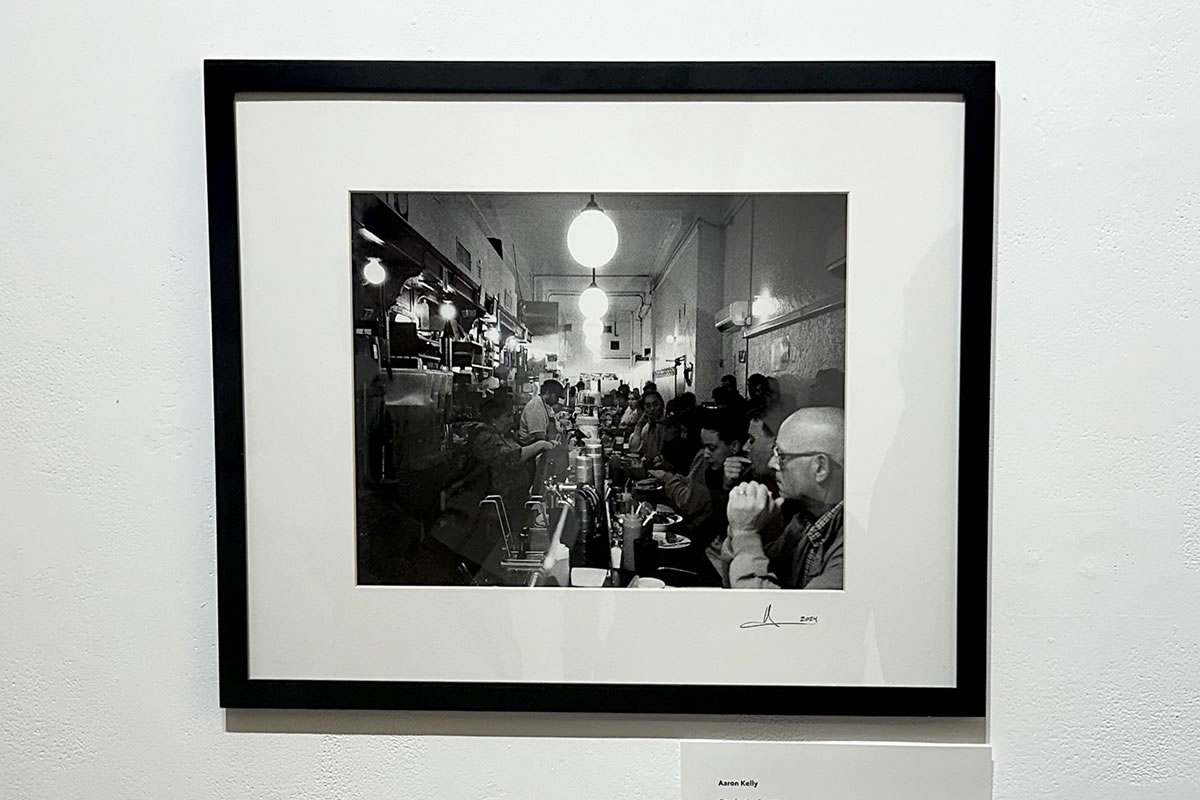A review by Martha Gutierrez
How do we capture the essence of human experience? In an era where AI-generated images inundate social media and permeate the world of image-making, how does photography preserve the authenticity of tangible and physical experiences? The juried exhibition “Of Flesh and Blood” opened yesterday at 35 Meadow Street Studios, Brooklyn, NY, offering a compelling answer. This exhibition brings together a diverse array of photographers whose works explore the theme of physicality, examining what makes us inherently human. Presented by Us for the Arts and juried by notable photographers Erica Reade and Gaspar Marquez, this event redirects our attention to the unfiltered essence of human experience, reminding us of the profound impact of our connection with the physical world in an increasingly digital age.
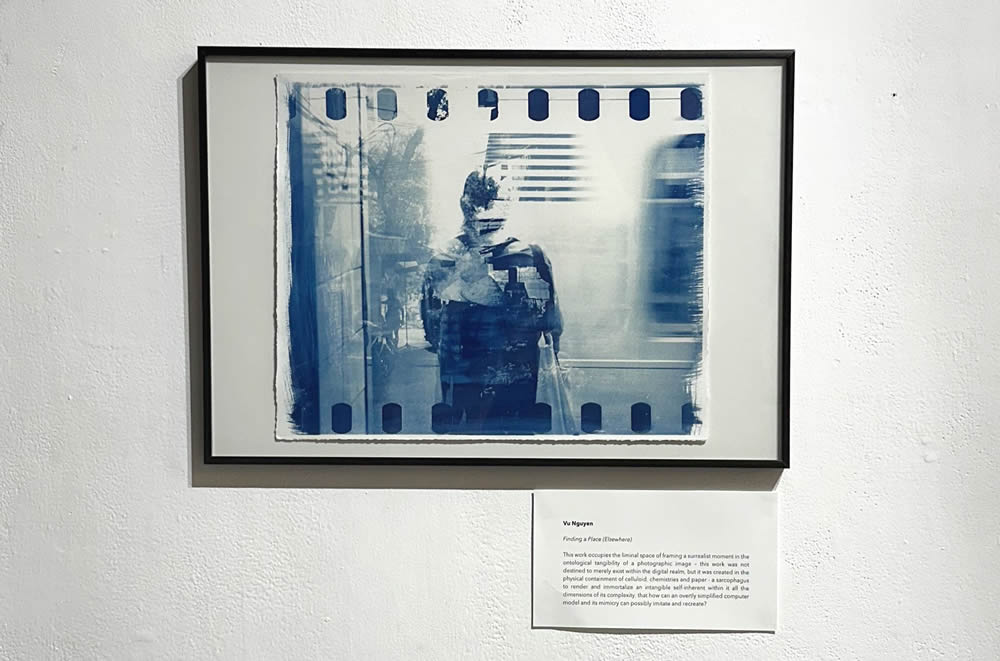
Vu Nguyen “Finding a Place (Elsewhere)”
As we entered the gallery, we were welcomed by Vu Nguyen’s “Finding a Place (Elsewhere).” Nguyen presented a cyanotype whose material presence captivated viewers. With its rough edges and bold, deep blue color, the photograph’s blend of existing objects, people, and intangible elements gave the piece a ghostly quality. Created with celluloid and chemistry, Nguyen’s photographs challenge the notion of digital mimicry, emphasizing the unique complexity and depth that only alternative photographic processes can capture. His work occupies a liminal space, creating a surrealist image of ontological tangibility.
The show continued to capture attention with “One for the Counter,” Aaron Kelly’s tribute to analog photography. Depicting a busy diner, the candid expressions of strangers under an aligned lighting display became more than just a snapshot of everyday life. Capturing an overlooked moment in the rush of modern existence, Kelly’s photograph compelled viewers to slow down and appreciate the fleeting beauty of human encounters. Using perspective and architectural details, Kelly’s image emphasized the importance of genuinely observing our surroundings and living in the present moment.
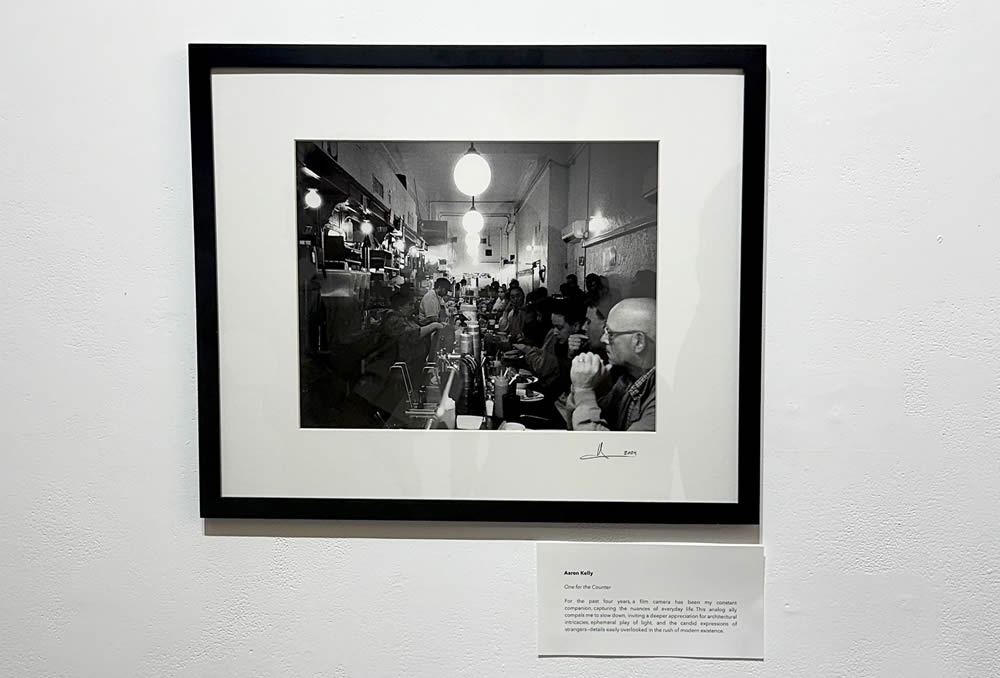
Aaron Kelly “One for the Counter”
In the center of the gallery, glowing with intense energy, stood Nika de Carlo’s photograph from her series “See You in Heaven,” which documents her recovery journey after years of addiction. Her photograph captured a moment of tenderness: a couple embraced. The male figure, ambiguously engaged, maintained balance with one hand on the bed, while the female, with her arms fully wrapped around her partner, gazed distantly with a glassy look. De Carlo’s work offered a poignant look at the power of human resilience and the importance of connection—both physical and emotional.
With a further sense of closeness, while offering a haptic experience, we found Anya Broido’s “The Skin of the City.” This mesmerizing black and white photograph depicting a man’s back skin, textured and weathered by the sun, belongs to a series where Broido explores the intersection of urban decay and human aging. Challenging perceptions of aging in youth-centric societies, her work celebrated resilience and the vibrancy of those who exist beyond the realm of social expectations, using the metaphor of the skin to depict trauma, evolution, and unity.
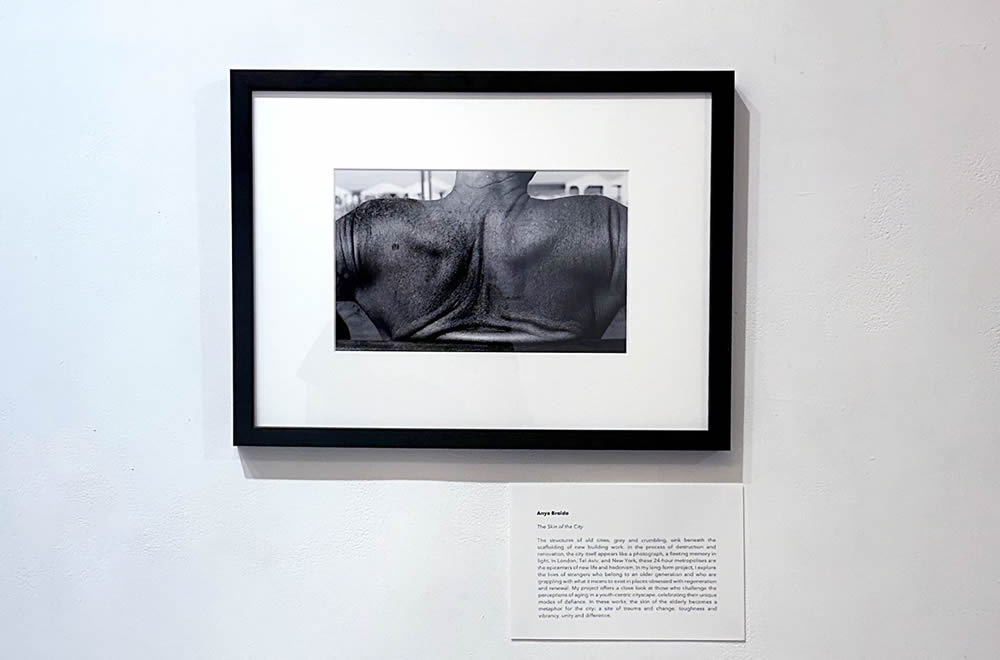
Anya Broido “The Skin of the City”
The exhibition also addressed the physical human experience from a political point of view. This was exemplified in Charlie Lederer’s “Signs of the Times.” In this diptych, the artist encapsulated the collective emotions of fear, anger, and hope during moments of social upheaval. Lederer’s work reflected the irreplaceable power of peaceful protest and the profound unity that arises when people come together physically to demand change. This theme of social agreement and physical presence serves as a powerful reminder of our shared humanity in the face of political transformations.
At the gallery’s back wall, we also found Michael Trimboli’s work “Rock Center in Winter.” His image was, in fact, quite captivating. Maintaining a safe distance in his capture, his photograph displayed an urban tableau emphasizing the isolation often felt in capitalist America. The bustling energy of Rockefeller Center, juxtaposed with the palpable sense of solitude among individuals, highlighted the paradox of crowded yet lonely city life. His work invited viewers to reflect on contemporary structures of power, the nature of urban living, and the disconnection that individuals suffer as a consequence of a market economy-based system.
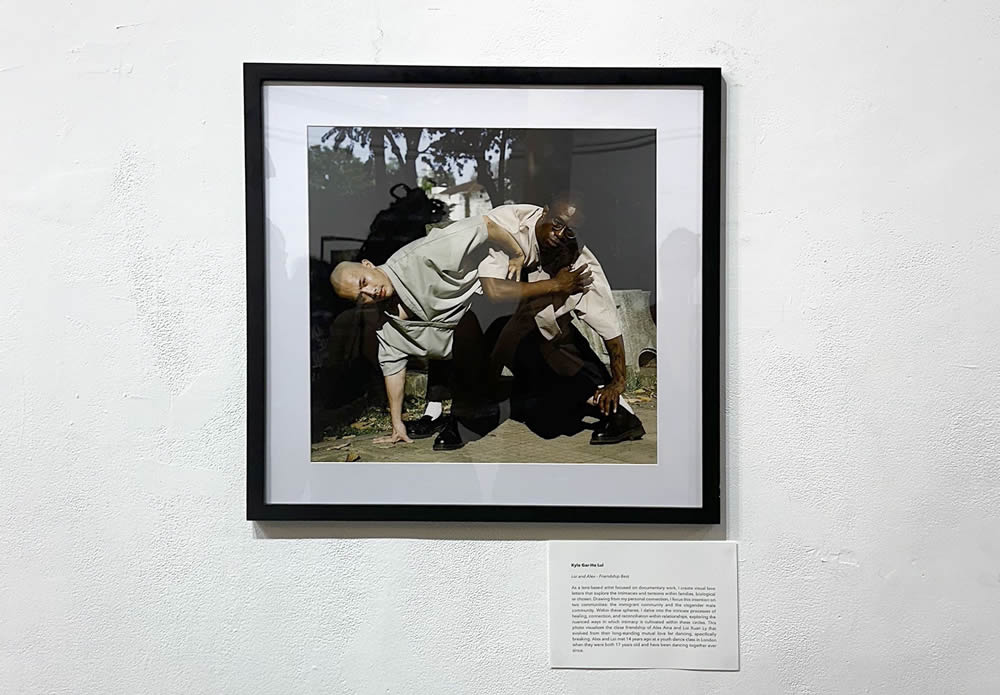
Kyle Gar-Ho Lui “Loi and Alex – Friendship Best”
Yoanny Aldaya’s photograph “Equilibrio (Balance)” offered another approach to the exploration of physicality in relation to social issues, but in his case, through self-representation. Using his body as the medium, Aldaya’s meticulously orchestrated image confronted viewers with the complexities of personal identity, material deficiencies, and social norms. His theatrical exploration of the human condition, presented in this photograph, referenced the act of labor, the home’s privacy, and the outside world’s impact on our personal experience. Aldaya’s work challenged the viewer to consider the weight of societal expectations and the delicate balance we maintain in navigating our lives under this pressure.
Continuing into the exploration of physicality through the representation of the human body, the show included “Denial,” a piece by Kimber Devaney. In this image, the artist explored personal emotions through self-portraiture. Shot on double-exposed film during low tide at the beach of Cape Cod, Devaney’s images conveyed the physical and emotional release associated with grief. Her work captured the profound connection with the earth and the journey towards healing and self-discovery, emphasizing the tactile and bodily experience of processing intense emotions.
Kendra Heisler’s “Out at the Russian Ballet” initially brought to the show what appeared to be a soft sense of calmness, only for viewers to realize that her work was, in fact, a silenced scream. Heisler’s work addressed issues of gender, power, and secrecy. The carefully composed image showed two female dancers on a simplified snowy background. Part of her series “Shot on a Scandal,” her photograph revealed hidden stories that initiated conversations about patriarchal practices. Heisler’s work was an invitation to delve into the conflict between societal conformity and individual expression, challenging viewers to question the roles and expectations imposed by society. Heisler’s work illuminated the often invisible forces underlying a masked society, making a powerful statement about the need for awareness and change.
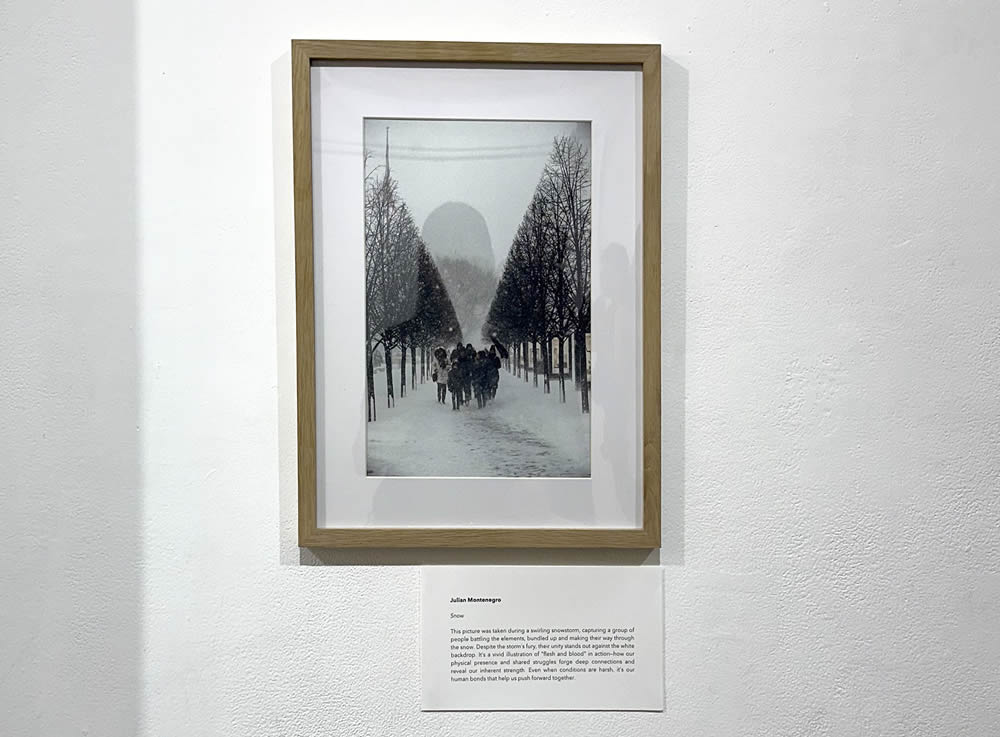
Julian Montenegro “Snow”
Movement and body harmony were also present in Kyle Gar-Ho Lui’s “Loi and Alex – Friendship Best.” The photograph captured two men, showcasing the physical connection and mutual support that define their relationship. Lui’s work documents the deep bonds formed through shared passions, highlighting the intimacy and evolution of chosen families within immigrant and cisgender male communities. In his work, he invited viewers to contemplate concepts of alignment within human relationships, the role of our bodies, and how they relate to each other, as well as define our connection, bonds, and friendships.
Closing the show with a message of unity, Julian Montenegro’s “Snow” illustrated the theme of physicality through shared struggles and human bonds, showcasing humans’ inherent strength and resilience in the face of adversity. The photograph depicted a group of people navigating a snowstorm, their union, standing out against the harsh white backdrop on a path defined by a line of trees. The individuals battling the elements underscored the human ability to endure and support one another, offering a powerful reminder of the warmth that human connections provide, even in the harshest of circumstances.
We left “Of Flesh and Bone” with a reinforced sense of belonging, powerfully reminded of the shared experiences and the physical aspects that define us as human beings. This thought-provoking exhibition took us on a journey through tactile, tangible, and deeply personal human life situations that digital experiences can’t replicate. Each artist highlighted different facets of physicality, from social unity and personal bonds to everyday nuances, grief, and resilience, creating a rich tapestry of human existence in the digital age. Judges Erica Reade and Gaspar Marquez exquisitely selected an impactful collection that spoke to the essence of human experience, fostering a deeper appreciation for the physical connections that bind us all and the way photography can uniquely capture and convey these profound aspects of our lives.

